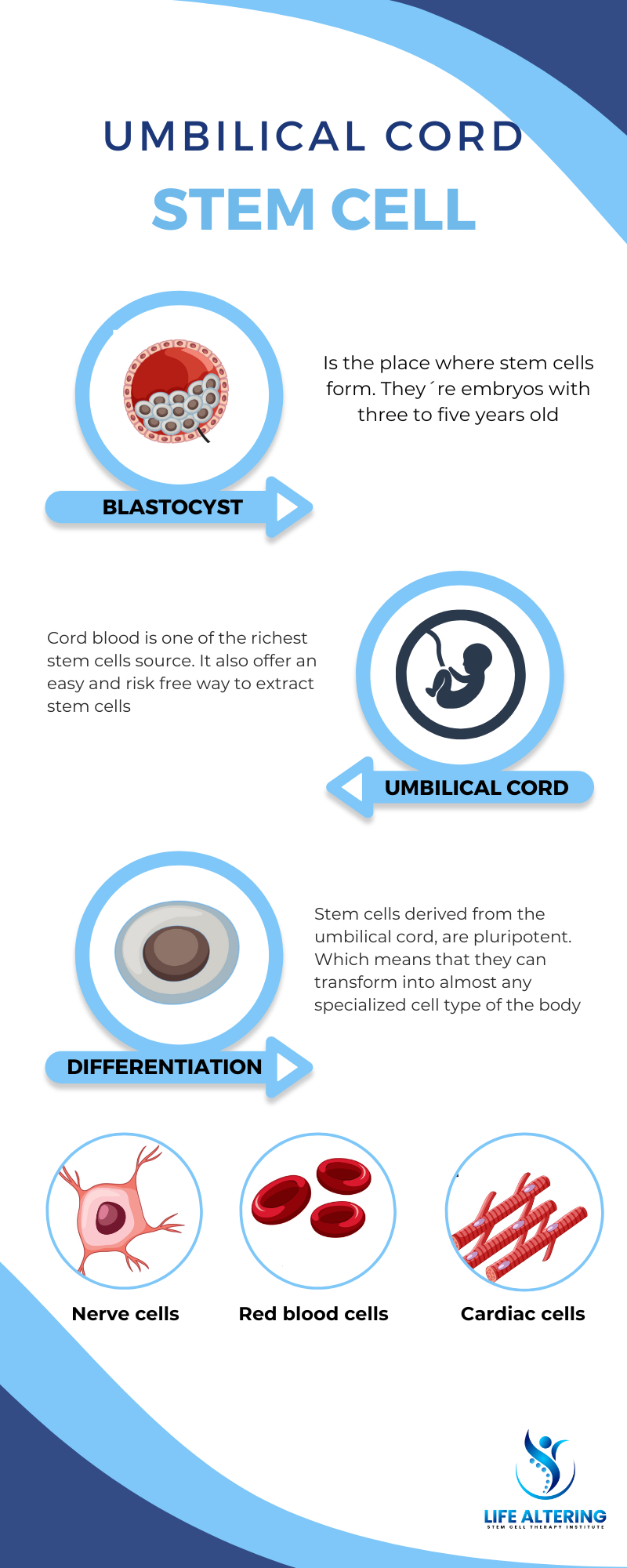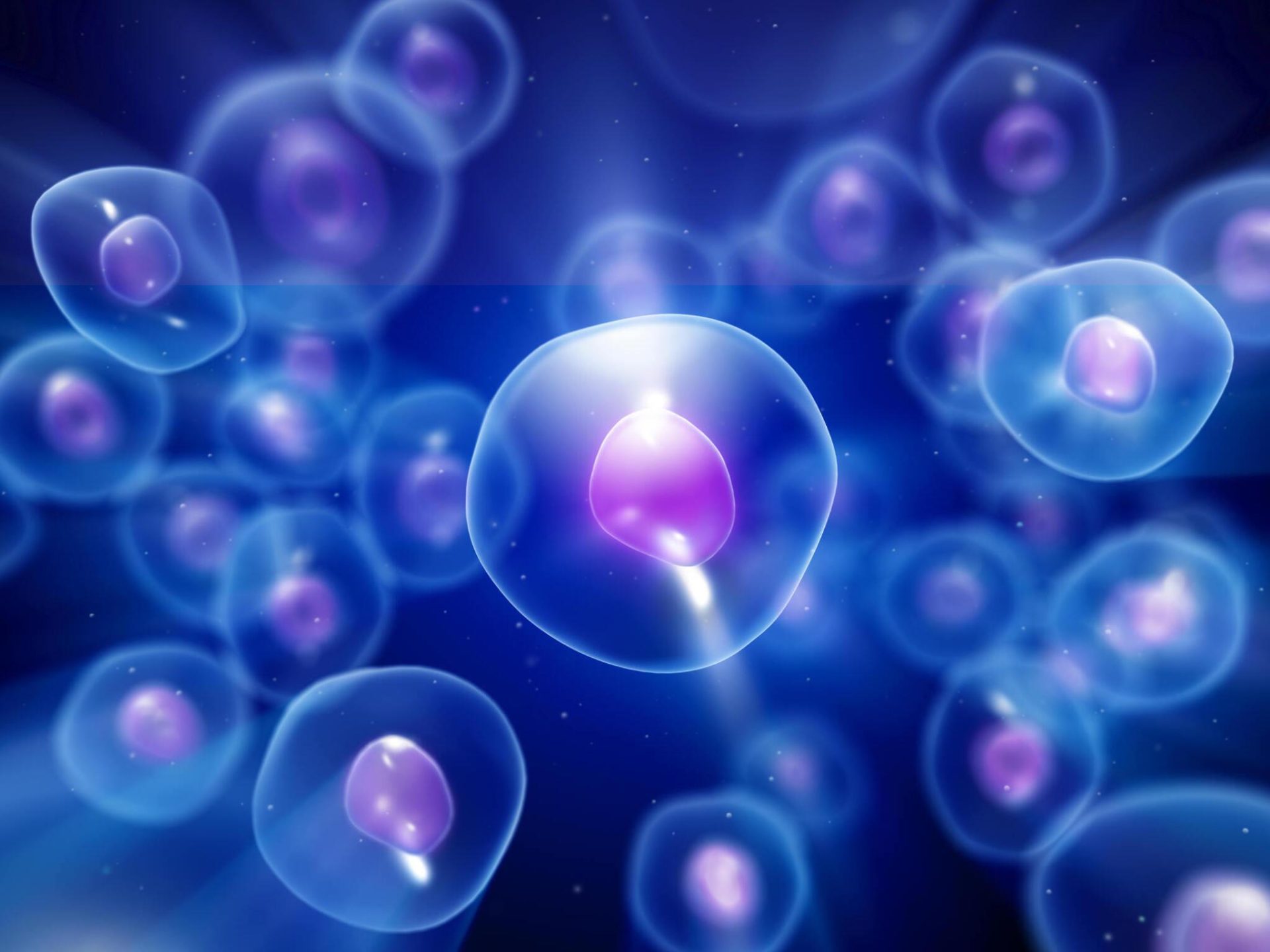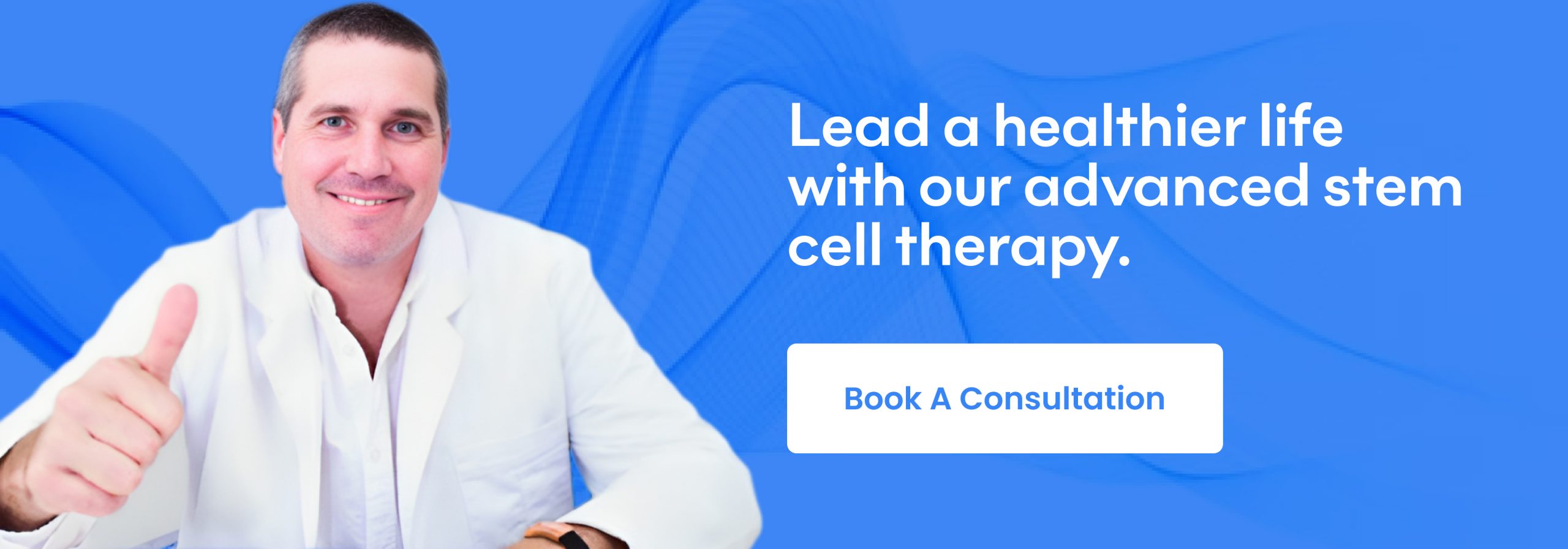The Power of Stem Cell Therapy: A Closer Look at Mesenchymal Stem Cells and Wharton’s Jelly
Stem cell therapy is revolutionizing the medical field, offering hope for conditions once deemed untreatable. This innovative approach harnesses the power of stem cells to repair, replace, and regenerate damaged tissues and organs. One of the most promising types of stem cells used in regenerative medicine is Mesenchymal Stem Cells (MSCs), particularly those derived from Wharton’s Jelly. This blog will explore the science behind MSCs, the unique properties of Wharton’s Jelly-derived MSCs, their immunomodulatory effects, and their potential in treating pulmonary fibrosis. Additionally, we will delve into clinical trials, the landscape of stem cell therapy in Mexico, and its costs, providing a comprehensive overview of this groundbreaking therapy.
What are Mesenchymal Stem Cells?
Mesenchymal Stem Cells (MSCs) are multipotent stem cells capable of differentiating into various cell types, including bone, cartilage, muscle, and fat cells. MSCs are prized for their ability to modulate immune responses, reduce inflammation, and promote tissue repair. These cells can be isolated from various tissues, including bone marrow, adipose tissue, and the umbilical cord.
Key Characteristics of MSCs
- Multipotency: Ability to differentiate into multiple cell types.
- Immunomodulation: Capable of modulating the immune system to reduce inflammation.
- Tissue Repair: Promote the repair and regeneration of damaged tissues.
- Homing Ability: Can migrate to sites of injury or inflammation.
What is Wharton’s Jelly?
Wharton’s Jelly is a gelatinous substance found within the umbilical cord. It surrounds the umbilical vein and arteries, providing protection and structural support. Wharton’s Jelly is rich in MSCs, which are easier to harvest and have higher proliferation rates compared to MSCs from other sources.
Unique Properties of Wharton’s Jelly
- Abundant MSCs: High concentration of MSCs, making it a potent source for regenerative therapies.
- Ethical Collection: Obtained non-invasively from donated umbilical cords post-birth.
- Young Cells: MSCs from Wharton’s Jelly are young and exhibit robust regenerative capabilities.
Wharton’s Jelly-Derived Mesenchymal Stem Cells (WJ-MSCs)
Wharton’s Jelly-derived MSCs (WJ-MSCs) are gaining attention for their exceptional regenerative and immunomodulatory properties. These cells can be used to treat a variety of conditions, including pulmonary fibrosis, a severe lung disease characterized by scarring of lung tissue.
Benefits of WJ-MSCs
- High Proliferation Rate: Rapidly divide and expand in culture.
- Potent Immunomodulation: Strong ability to modulate the immune response.
- Non-invasive Collection: Obtained ethically without harming the donor.
Read Also: Advanced Cost-Effective Stem Cell Treatment for Miami Patients
Immunomodulatory Effects of Wharton’s Jelly-Derived Mesenchymal Stem Cells
WJ-MSCs have remarkable immunomodulatory effects, which are crucial for treating autoimmune and inflammatory diseases. They can suppress pro-inflammatory cytokines and promote the production of anti-inflammatory cytokines, thus reducing inflammation and preventing tissue damage.
Mechanisms of Immunomodulation
- Cytokine Secretion: Release of anti-inflammatory cytokines.
- T-Cell Modulation: Suppress the activity of pro-inflammatory T-cells.
- Macrophage Polarization: Promote the transition of macrophages to an anti-inflammatory phenotype.
Mechanism of Action of WJ-MSCs on Pulmonary Fibrosis
Pulmonary fibrosis involves the thickening and scarring of lung tissue, leading to severe respiratory issues. WJ-MSCs can potentially reverse this damage through several mechanisms:
How WJ-MSCs Help in Pulmonary Fibrosis
- Anti-inflammatory Effects: Reduce lung inflammation, which is a primary cause of fibrosis.
- Anti-fibrotic Properties: Inhibit the processes that lead to scar tissue formation.
- Regenerative Capacity: Promote the repair and regeneration of damaged lung tissue.
Clinical Trials in the Field of Cell Therapy Using Mesenchymal Stem Cells in Pulmonary Fibrosis
Clinical trials are crucial in establishing the efficacy and safety of stem cell therapies. Several trials are underway to investigate the use of MSCs, including WJ-MSCs, in treating pulmonary fibrosis.
Key Findings from Clinical Trials
- Safety: WJ-MSCs have been shown to be safe with no serious adverse effects.
- Efficacy: Preliminary results indicate improvements in lung function and reduction in fibrosis markers.
Stem Cell Therapy: An Overview
Stem cell therapy involves the transplantation of stem cells to repair or replace damaged tissues and organs. It has shown promise in treating a variety of conditions, from neurological disorders to cardiovascular diseases.
Read Also: Unlocking the Potential of Stem Cells for Heart Failure and Stroke Recovery
Applications of Stem Cell Therapy
- Neurological Disorders: Treatment of stroke, spinal cord injuries, and neurodegenerative diseases.
- Cardiovascular Diseases: Repair of heart tissue post-myocardial infarction.
- Orthopedic Conditions: Treatment of joint and bone injuries.
Stem Cell Therapy in Mexico
Mexico has become a hub for stem cell therapy, attracting patients worldwide due to its advanced medical facilities and affordable treatment options. The country offers high-quality care with significantly lower costs compared to the United States and Europe.
Cost of Stem Cell Therapy in Mexico
- Affordability: Treatments in Mexico can be up to 70% cheaper than in the U.S.
- Quality of Care: Many clinics, such as Life Altering Stem Cell Therapy Institute, are American-owned and operated, ensuring high standards of care.
Key Clinics in Mexico
- Life Altering Stem Cell Therapy Institute: American-owned and operated, specializing in the use of Wharton’s Jelly-derived MSCs for various treatments.
Follow-up and Outcomes
Post-treatment follow-up is crucial to monitor the patient’s progress and ensure the success of stem cell therapy. Regular check-ups and assessments help track the efficacy of the treatment and manage any potential side effects.
Monitoring Progress
- Regular Assessments: Periodic evaluations to monitor improvement in symptoms.
- Patient Feedback: Collecting data on patient experiences and outcomes.
- Adjustments: Modifying treatment protocols based on individual responses.
Conclusion
Mesenchymal Stem Cells (MSCs), particularly those derived from Wharton’s Jelly, represent a promising frontier in regenerative medicine. Their unique properties make them ideal for treating a range of conditions, including pulmonary fibrosis. Clinical trials continue to validate their efficacy and safety, paving the way for broader applications. Stem cell therapy in Mexico offers an affordable and high-quality alternative for patients seeking advanced treatments. With ongoing research and clinical advancements, MSCs hold the potential to revolutionize medical care and improve the lives of countless individuals.
How does Stem Cell Therapy Work to Fix a Torn Rotator Cuff?
Stem cell therapy is a revolutionary approach with proven efficacy in treating orthopedic conditions, including shoulder injuries and rotator cuff tears. The human shoulder comprises a ball-and-socket joint responsible for a tremendous range of motion. The extremities in shoulder movements, such as 360-degree rotation, exert pressure on the joints, tendons, and muscles, resulting in injury. Although pain medications and proper rest can treat minor tears, chronic cases need proper medical attention to avoid long-term difficulties.
Surgery is a conventional treatment for torn rotator cuffs resulting from sports injuries or accidental falls. However, it poses risks of side effects and post-surgery complications. Stem cell therapy is a new and innovative treatment for shoulder pain caused by rotator cuff tears, tendonitis, shoulder arthritis, and others. Let’s discuss how the therapy works, its potential advantages, and post-treatment recovery.
Table of Contents
What is a Rotator Cuff Tear?
Rotator cuff tear is a type of shoulder injury involving a tear in the tissues connecting muscles to bones around the shoulder joint. Common symptoms include intense pain, difficulty moving the shoulder, and progressive weakness in the affected muscles.
Rotator cuff strains are caused by excessive wear and tear over time, acute injury, and overuse. Furthermore, the intensity of the injury might range from mild to severe. Rotator cuff tears are most likely to impact tennis players who serve overhead and anyone experiencing strain or tear after a car accident, fall, or sudden injury.
Advanced Stem Cell Therapy to Fix a Torn Rotator Cuff
Long-term overuse of the shoulder is one of the primary reasons for rotator cuff tears. People at risk for this degenerative injury include athletes and workers in lifting jobs. Stem cell therapy is a promising non-surgical treatment that can repair damaged tissues and enhance the body’s natural healing capabilities.
Stem cells have the unique potential to differentiate into any cell type and promote tissue regeneration. Stem cell therapy for shoulder pain utilizes the regenerative potential of the cells to regrow healthy tissues and replace the damaged tissues in the injured shoulder. It is a novel regenerative approach serving as an effective alternative to shoulder surgeries or other conventional treatments.
Stem cell treatment supports the body’s repair mechanism and promotes healing naturally from within. For example, in the case of rotator cuff tears, stem cells renew healthy cells in the bones and muscles and improve blood flow at the injury site.
Read Also: Healing Power Of Stem Cell Therapy: A Comprehensive Guide
Benefits of Stem Cell Therapy for Shoulder Pain due to Rotator Cuff Tears
Compared to harsher surgical treatments for rotator cuff tears, stem cell therapy is a better alternative as it is minimally invasive with a shorter recovery period. It is, therefore, a safe and viable option for athletes to enhance recovery from the injury. They can regain range of motion and optimize performance through natural healing.
Stem cell therapy is an effective treatment option for rotator cuff tear symptoms and to promote recovery. Injecting stem cells into the affected joints offers numerous benefits.
- It is a non-surgical and less invasive medical procedure that doesn’t require any incision or cut on the skin.
- Stem cells repair the damaged tissues and regrow healthy cells, reducing inflammation and pain.
- Stem cell therapy effectively restores shoulder function and improves its range of motion.
- Stem cells reduce scar formation and prevent further wear and tear of the cartilage in the affected shoulder.
- The newly introduced stem cells release growth factors and act on the surrounding tissues to restore a healthy environment for healing.
Post-treatment recovery
Compared to surgery, cell-based therapy supports faster recovery and reduces downtime. It is an outpatient procedure that doesn’t require prior hospitalization. With restricted shoulder movements, one can resume a normal routine within one or two days of the treatment.
In most cases, doctors recommend physiotherapy to support stem cell treatment. This enables healthy blood flow to the diseased area and promotes faster recovery from the damage. Patients need to attend regular follow-up sessions with the concerned doctors, who inform them about the progress and improvements in their symptoms.
Recovery time may vary from person to person since every individual is different. Some might need more time to heal, while others might return to an everyday and active life sooner. However, one must avoid strenuous activities that might impact the treated area by imposing pressure.
Although stem cell therapy doesn’t require lengthy rehabilitation, patients need time to restore the range of motion and mobility in the treated joints.
Read Also: Stem Cell Therapy For Myocardial Infarction: A Therapeutic Hope
Which is the best institute for stem cell therapy for rotator cuff repair?
Numerous stem cell therapy clinics offer regenerative medicine treatment worldwide for various orthopedic conditions, including rotator cuff tears. Mexico is one of the best places for medical tourism, known for its advanced treatment technologies and robust healthcare system. Moreover, it is home to esteemed medical professionals and stem cell experts, making it easier for patients to access cutting-edge stem cell treatments.
Life Altering Stem Cell Therapy Institute is a reputed clinic that provides affordable stem cell therapy in Mexico. Patients can get advanced treatments for various medical conditions, including orthopedic injuries, autoimmune diseases, neurological disorders, fertility issues, and age-related problems.
You can fill out our patient application form or book a consultation with our expert to determine whether you are eligible for stem cell therapy for a rotator cuff tear. Our healthcare professionals have a proven record of successfully treating orthopedic conditions like knee, back, and shoulder pain and rotator cuff tears. Our stem cell center in Mexico ensures smoother recovery of our patients with holistic treatment and compassionate care.
Final thoughts
Stem cell therapy for rotator cuff tears is a novel treatment that utilizes stem cells of the patient’s body or donors to address the pain and inflammation. It is a safe, non-surgical procedure without complications or adverse side effects. Most treatment centers use human umbilical cord tissue-derived mesenchymal stem cells (HUCT-MSCs) to avoid the ordeal of collecting cells from the patient’s bone marrow or adipose tissue. HUCT-MSCs are new cells extracted from the umbilical cords of newborn babies after healthy births, which eliminates the chances of cell rejection.
Stem cell interventions ensure an easy journey of recovery for patients suffering from a torn rotator cuff. They aid in the natural healing of the injured area through tissue repair and regeneration. The therapy shows a path towards a healthier and pain-free tomorrow.
Transforming Healthcare: The Ultimate Guide to Mesenchymal Stem Cells
In the realm of regenerative medicine, the spotlight is now on a remarkable source of healing potential – umbilical cord mesenchymal stem cells. This comprehensive guide aims to unravel the intricacies of harnessing the power within these unique cells for therapeutic purposes. As we delve into the wonders of umbilical cord-derived stem cells, we will explore their potential in revolutionizing medical treatments, with a particular focus on their role in stem cell therapy in Mexico.
The Marvel of Umbilical Cord Mesenchymal Stem Cells:
Umbilical cord mesenchymal stem cells (UC-MSCs) are a treasure trove of regenerative capabilities. Sourced from the Wharton’s jelly of the umbilical cord, these cells exhibit remarkable versatility, with the potential to differentiate into various cell types. Their unique properties make them a compelling option for regenerative therapies, offering a beacon of hope for individuals seeking advanced medical interventions.
Stem Cell Therapy in Mexico: A Global Hub for Regenerative Medicine:
Mexico has emerged as a leading destination for individuals seeking cutting-edge stem cell treatments. With a commitment to advancing regenerative medicine and a cadre of skilled medical professionals, Mexico provides a conducive environment for the application of innovative therapies. Stem cell treatments in Mexico, including those utilizing umbilical cord mesenchymal stem cells, represent a beacon of hope for patients from around the world.
The Science Behind Umbilical Cord Mesenchymal Stem Cells:
Understanding the science behind UC-MSCs is fundamental to appreciating their therapeutic potential. These stem cells possess unique immunomodulatory properties, meaning they can modulate the immune system’s response. This immunomodulation plays a crucial role in reducing inflammation and promoting tissue repair, making UC-MSCs a powerful tool in the treatment of various medical conditions.

A Symphony of Healing: How UC-MSCs Work Their Magic:
Umbilical cord mesenchymal stem cells orchestrate a symphony of healing within the body. When introduced into a patient’s system, these cells home in on areas of inflammation or injury. Through a combination of differentiation into specialized cells and the release of bioactive molecules, UC-MSCs stimulate the repair and regeneration of damaged tissues. This dynamic process sets the stage for a holistic and targeted approach to healing.
The Unparalleled Advantages of Umbilical Cord Mesenchymal Stem Cells:
UC-MSCs offer distinct advantages that contribute to their prominence in regenerative medicine. Their youthfulness, compared to stem cells from other sources, enhances their proliferative and differentiation capacities. Additionally, the non-invasive collection process from donated umbilical cords ensures an ethically sound and readily available source of potent stem cells.
Stem Cell Therapy Applications: From Orthopedics to Neurological Conditions:
The versatility of UC-MSCs extends their applications across a spectrum of medical conditions. In the field of orthopedics, these cells show promise in the regeneration of damaged cartilage and tissues, making them invaluable for treating joint disorders. Moreover, ongoing research explores the potential of UC-MSCs in addressing neurological conditions, offering a glimpse into a future where disorders like Parkinson’s and Alzheimer’s may find innovative therapeutic solutions.
The Journey of Stem Cell Therapy in Mexico:
Mexico’s journey in the realm of regenerative medicine has been marked by advancements and a commitment to providing cutting-edge treatments. Stem cell therapy in Mexico has gained international recognition, attracting patients seeking alternatives to conventional medical approaches. The collaborative efforts of Mexican healthcare professionals, coupled with the country’s regulatory frameworks, position it as a hub for transformative stem cell treatments.
Navigating Regulations and Ensuring Safety:
The success of stem cell therapy in Mexico is underpinned by a commitment to stringent regulations and safety standards. Regulatory bodies ensure that stem cell treatments adhere to established guidelines, safeguarding the well-being of patients. This dedication to safety and ethical practices reinforces the trust placed in Mexico as a destination for regenerative medicine.
Breaking Barriers: Accessibility and Affordability of Stem Cell Treatments:
An undeniable advantage of seeking stem cell therapy in Mexico is the accessibility and affordability of treatments. This breaks down barriers for individuals who may find these innovative therapies financially out of reach in other parts of the world. Mexico’s commitment to providing cutting-edge treatments without compromising quality underscores the democratization of regenerative medicine.
Read Also: Revolutionizing Relief: Mesenchymal Stem Cells Break the Chains of Chronic Back and Neck Pain
Patient Stories: Realizing the Promise of Healing:
The true measure of the impact of stem cell therapy lies in the stories of individuals whose lives have been transformed. Patient testimonials highlight the potential of UC-MSCs in alleviating symptoms, improving quality of life, and, in some cases, halting the progression of debilitating conditions. These narratives underscore the profound impact that regenerative medicine, particularly stem cell therapy, can have on the lives of those seeking hope beyond conventional treatments.
Conclusion: Embarking on a Journey of Healing:
As we navigate the realm of regenerative medicine, umbilical cord mesenchymal stem cells emerge as a beacon of hope, promising a transformative journey toward healing. Stem cell therapy in Mexico, with its commitment to innovation and patient-centric care, adds a global dimension to this odyssey. The promise of UC-MSCs opens new doors for individuals seeking advanced medical interventions, inviting them to embark on a path where the power of regenerative medicine meets the spirit of hope and healing.




